
94% of researchers rate our articles as excellent or good
Learn more about the work of our research integrity team to safeguard the quality of each article we publish.
Find out more
ORIGINAL RESEARCH article
Front. Oral. Health, 11 April 2025
Sec. Oral Epidemiology
Volume 6 - 2025 | https://doi.org/10.3389/froh.2025.1577870
This article is part of the Research TopicWell-Being of Dental Professionals and Workplace ChallengesView all 5 articles
 Abanoub Riad1,2,3
Abanoub Riad1,2,3 Lamis Elsheikh1*
Lamis Elsheikh1* Silvi Domnori1,4,5
Silvi Domnori1,4,5 Aurora Doris Fratila1,6
Aurora Doris Fratila1,6 Charlotte Carter7
Charlotte Carter7 Deniz Devrim Kaya1,5
Deniz Devrim Kaya1,5 Ekaterina Volevach8
Ekaterina Volevach8 Rachael England9
Rachael England9 Mariana Morgado1,10
Mariana Morgado1,10 Julien Issa11,12
Julien Issa11,12 Sameh Attia13
Sameh Attia13 Mick Armstrong9
Mick Armstrong9 Doniphan Hammer9
Doniphan Hammer9 Azamat Baigulakov9
Azamat Baigulakov9 IADS Delegates1 and EDSA Delegates7
IADS Delegates1 and EDSA Delegates7
Background: Dental students' career choices are shaped by many factors, including their personal abilities and goals, environmental factors and the resources available to them. Understanding the drivers for this career pathway decision is crucial for educational institutions' development of comprehensive curricula. This study applies Social Cognitive Career Theory (SCCT) to investigate the professional aspirations of dental students globally, providing insights into the factors that influence career choices of dental students from different regions to understand how personal, socioeconomic and cultural differences influence their decisions.
Methods: A cross-sectional, multicentred survey was conducted between May and July 2023, involving 1964 dental students from over 20 countries. Self-administered questionnaires based on SCCT were used to assess participants' self-efficacy, professional and personal outcome expectations, career goals, and career path preferences. Statistical analysis, including multivariable logistic regression and mediation analysis, was employed to identify the relationships between the SCCT framework, sociodemographic factors and career aspirations.
Results: The study revealed that 51.2% of participants preferred a specialty in clinical dentistry, while 28.1% aimed for general dentistry. Mediation analysis demonstrated notable pathways from career planning training to career aspirations through self-efficacy, professional and personal expectations. Self-efficacy mediated 26.7%–98.65% of the effect on career preferences coming forward as a key mediator. Demographic statistics demonstrated that regional and economic differences significantly impacted students’ career choice, where students from higher-income countries reported more likely to choose general dentistry and those from lower-income countries were more drawn to specialty fields or public health.
Conclusions: This study offers new insights into the global career aspirations of dental students through the prism of the SCCT. These findings highlight the need for dental schools and associations to offer tailored career planning training based on students' backgrounds at an early phase of their education. Providing support and career guidance, especially in underserved regions, can help students make informed decisions that align with their personal and professional goals. This will ultimately contribute to a more diverse and well-prepared global dental workforce.
Career aspirations encompass the professional objectives individuals establish for themselves, which subsequently inform their decision-making processes and delineate their professional trajectories. Per young adults, career aspirations bear particular significance, as this transitional stage entails the formation of professional identities and the pursuit of designated career paths (1). The examination of young adults' career aspirations yields valuable insights into their motivations, values, and expectations, thereby enabling the development of tailored interventions and support mechanisms to facilitate their professional advancement and achievements (2). Discerning the elements that influence these aspirations additionally facilitates the identification of potential barriers and opportunities for intervention, ensuring that young adults are sufficiently equipped to successfully navigate the intricate and dynamic landscape of professional endeavours (2, 3).
Higher education significantly influences students' career aspirations, including those pursuing dental education (2). While dental schools play a crucial role in equipping students with the requisite knowledge and skills to practice their chosen profession (4, 5), other entities such as dental student organisations, dentist associations and similar NGOs also contribute to shaping their diverse career trajectories, thereby fostering awareness of the extensive opportunities available within the healthcare domain. By collaborating with dental schools, through mentorship programs, career guidance services and professional networks, these organisations provide students with awareness of extensive opportunities within the healthcare domain and support their professional development (5, 6). Altogether this apparatus of institutions guides students in navigating the intricate network of professional endeavours, casting light on the diverse career alternatives and nurturing the competencies necessary for success in these paths (6). Consequently, elucidating the significance of the combined role of dental education institutions, dental professional organizations and student-led NGOs in shaping students' career choices and aspirations is essential for cultivating a well-prepared and motivated workforce, capable of facing the evolving demands of the dental profession and enhancing oral health outcomes for the broader population (7).
The Social Cognitive Career Theory (SCCT) offers an invaluable framework for comprehending dental students' career aspirations. This theory, formulated by Lent, Brown, and Hackett, posits that career development is governed by three principal elements: self-efficacy, outcome expectations, and personal goals (8, 9). Self-efficacy pertains to an individual's conviction in their capacity to successfully execute a particular task or attain a specific outcome. Outcome expectations represent the anticipated repercussions of engaging in a particular behaviour, while personal goals embody an individual's commitment to pursuing a designated career trajectory (10, 11). By employing SCCT to examine dental students' career aspirations, crucial insights can be gained into the factors that motivate and direct their professional selections and pinpoint potential areas for targeted interventions. For instance, augmenting self-efficacy and providing realistic outcome expectations may encourage students to investigate a broader array of career options within the dental field, while fostering the development of well-defined personal goals can support their long-term career success and satisfaction. Moreover, the SCCT framework can assist educators, administrators, and policymakers in dental education institutions to more comprehensively understand the factors driving students' career decisions, empowering them to devise more efficacious and tailored learning environments that foster career development and ultimately enhance the calibre of the dental workforce.
Understanding the career goals of dental students is essential for developing tailored interventions and support systems that foster their success and professional progress (5, 7). Through a variety of direct and indirect channels, dental education institutions have a crucial role in influencing students' career choices and objectives. Career planning training tailored to the specific needs of dental students globally can eventually lead to a more prepared and motivated dental workforce capable of addressing the changing needs of the dental profession and enhancing the general public's oral health outcomes in a broader array (5).
The overarching goal of this study was to examine the career aspirations of dental students from various countries and regions using a self-administered questionnaire grounded in SCCT. The primary objectives were: (a) to explore the relationships between self-efficacy, outcome expectations, and personal goals as outlined in the SCCT framework and their impact on dental students' career aspirations; and (b) to identify key factors influencing these aspirations, including sociodemographic variables and educational experiences. The secondary objectives were: (a) to investigate students' specific career preferences; and (b) to examine their preferred agencies and media for career planning training.
An analytical multicentre cross-sectional survey-based study was conducted between May and June 2023, to explore the career intentions of undergraduate dental students and recent graduates worldwide. The study adhered to the Strengthening the Reporting of Observational Studies in Epidemiology (STROBE) guidelines for cross-sectional studies, and data was collected via an online self-administered questionnaire (SAQ) using KoBoToolbox (Kobo Inc., Cambridge, MA, USA, 2023) (12, 13).
This study emerged from a collaborative initiative between the World Dental Federation (FDI), the International Association of Dental Students (IADS), and the European Dental Students Association (EDSA). After protocol finalisation, ethical clearance, and instrument validation, national delegates from IADS and EDSA were briefed about the study. Interested delegates received a single-login URL to access the SAQ, preventing duplicate responses. To enhance representativeness, data collectors used social media, instant messaging, printed materials, and direct emails via IADS and EDSA mailing lists. While efforts were made to engage underrepresented regions through national dental associations and student leaders, the online survey's voluntary nature may have introduced self-selection bias, favouring students more engaged in digital platforms and dental organisations.
The target population encompassed dental students and those who had graduated recently. Inclusion criteria stipulated that participant should: (a) either be an undergraduate dental student enrolled in a full-time degree programme; be an intern dentist where vocational training was mandatory for professional licensure; or have graduated after 1 January 2020; (b) be at least 18 years of age; and (c) have given their consent to participate in the study. Conversely, the exclusion criteria were: (a) being enrolled in preparatory courses, like pre-dental, or having graduated before 1 January 2020; (b) being younger than 18 years; and (c) not having given consent for study participation.
Given the global scope and the diverse representation from various regions, a pooled analysis approach was utilised. The data from all participating countries were aggregated to ensure a robust analysis. The sample size was determined to achieve a confidence level of 95% with a more precise margin of error of 2.5%, as calculated using Epi Info™ version 7.2.4 (14). The required minimum sample size for this study was 1,532 valid responses.
The SAQ comprised multiple-choice and Likert-like scale items categorised as follows:
(a) sociodemographic characteristics, encompassing gender, age, nationality, country of study, academic year, university type (public vs. private), and study loan (yes vs. no);
(b) self-efficacy regarding the ability to determine one's career path;
(c) outcome expectations (both professional and personal ones) of selecting specific career paths;
(d) goals to be realised through chosen career paths; and
(e) preferred career paths and learning resources to facilitate career planning.
The SAQ was based on the SCCT scale for medical students developed by Rogers et al. to evaluate self-efficacy, outcome expectations and career goals (11). Rogers scale demonstrated robust internal validity. Content validity was achieved by aligning items with the SCCT theoretical model and obtaining feedback from an expert review panel on the relevance of the scale items. Construct validity was further established through confirmatory factor analysis (CFA) ensuring its feasibility for use in subsequent research (11).
To validate the SAQ, a panel of experts in dental practice policy, dental education, health psychology, and dental public health was consulted. These experts provided feedback on the SAQ items. Based on their insights, necessary amendments were made to the items to enhance their relevance and clarity. Moreover, the CFA of SCCT components indicated an acceptable fit of the model to the data with a χ2/df ratio of 6.28. The Root Mean Square Error of Approximation (RMSEA) was 0.0519, with a 90% confidence interval of 0.0495–0.0542, indicating a reasonable fit. The Comparative Fit Index (CFI) was 0.936, and the Tucker–Lewis Index (TLI) was 0.929, both suggesting acceptable fit. Additionally, the Standardized Root Mean Square Residual (SRMR) was 0.0392, indicating a good fit.
The SAQ was produced primarily in English, but to maximise coverage and reduce sampling bias, versions in Albanian, Arabic, Czech, French, German, Indonesian, Italian, Spanish, and Turkish were also developed. The choice of languages was based on the logistical capabilities of the investigators' team. For each language, two independent forward translations were conducted. A review panel then compared these translations to produce a consensus version for each language (Supplementary Table S1).
The socioeconomic categorisation of countries was based on the World Bank (WB) classification: low income, lower middle income, upper middle income, and high income (15). Geographically, countries were classified as per the FDI geopolitical scheme into: Africa, Asia Pacific, Europe, Latin America, and North America (16).
For the outcome variables, self-efficacy was measured using 7 items, each graded on a 5-point Likert-like scale ranging from “Strongly Disagree (1)” to “Strongly Agree (5)”. The overall self-efficacy score was calculated as a composite of all items in this domain, thus ranging between 7 and 35. Similarly, the professional outcome expectations had 8 items with a total score ranging between 8 and 40, and the personal outcome expectations had 4 items with a total score ranging between 4 and 40. Goals had 6 items with a total score ranging between 6 and 30.
The initial sample comprised 2,293 respondents. Rigorous techniques were employed to remove low-quality entries and ineligible participants (17). The reasons of responses removal included graduation year (n = 8), age limitation (n = 14), response duration (n = 182), and response pattern (n = 125). Following these refinements, the final sample consisted of 1,964 respondents (Supplementary Figure S1).
This study was carried out in accordance with the Declaration of Helsinki for research involving human subjects, and it was thoroughly reviewed and approved by the Ethics Committee of the Faculty of Medicine, Masaryk University (decision no. 12/2023). All participants had to provide their informed consent digitally prior to getting access to the SAQ.
Statistical analysis was conducted using SPSS version 28 and the R-based package Jamovi (18, 19). Descriptive statistics used frequencies, percentages, means, and standard deviations. The Shapiro–Wilk test assessed normal distribution with a significance level (p.) < 0.05. Inferential statistics, e.g., Chi-squared (χ2), Mann–Whitney (U), Kruskal–Wallis (H), multivariable logistic regression, and mediation analyses were performed with a significance level (p.) less than 0.05.
The study included 1,964 participants, of whom 71.8% were female and 28.2% were male, with a mean age of 22.42 ± 2.85 years. Nearly two-thirds (66.7%) were enrolled in clinical years, and 7% were recent graduates: 0.6% from the class of 2020, 2.4% from 2021, 2.5% from 2022, and 1.5% from 2023. The majority (87%) were domestic students, meaning they were studying in their country of nationality (Table 1).
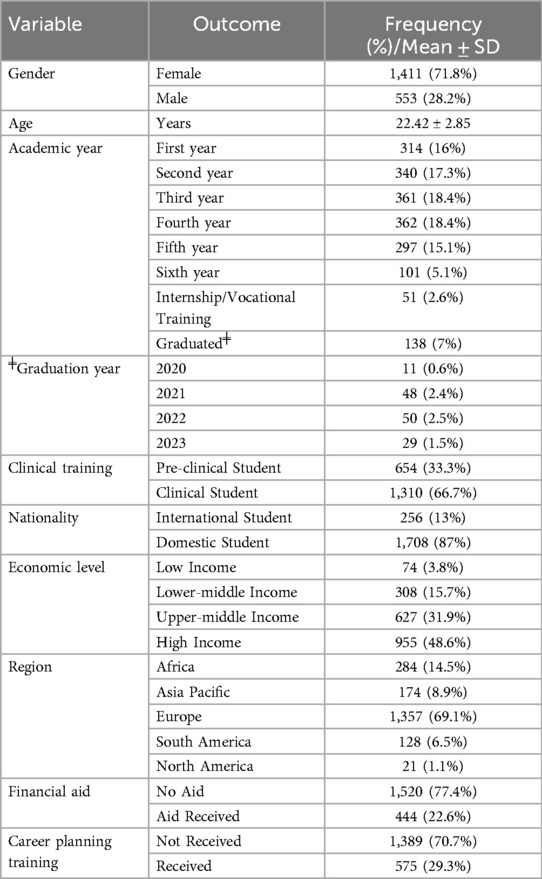
Table 1. Sociodemographic characteristics of dental students participating in FDI–IADS–EDSA survey of career planning, May–July 2023, (n = 1,964).
According to the World Bank classification, 48.6% studied in high-income countries, 31.9% in upper-middle-income countries, 15.7% in lower-middle-income countries, and 3.8% in low-income countries. Most participants were studying in Europe (69.1%), followed by Africa (14.5%) and the Asia Pacific region (8.9%). Financial aid was received by 22.6% of the participants, and 29.3% reported receiving career planning training (Supplementary Table S2).
When asked about their confidence in choosing a career path, 25.6% of participants expressed uncertainty about selecting a career that would fulfil their expectations and goals, 24.8% were unsure about choosing a career that would fit their personality type, 25.2% doubted their ability to choose a career that would enable them to live the desired lifestyle, and 21.4% were uncertain about selecting a career that aligned with their interests and abilities. Furthermore, 44.9% were unsure about what they were willing to sacrifice for their career path, 24.6% could not determine what they valued most in a medical career, and 42.6% struggled to find valid and accurate information for making their career choice. The mean score of the self-efficacy subscale was 26.75 ± 4.67 (range: 7–35) (Table 2).
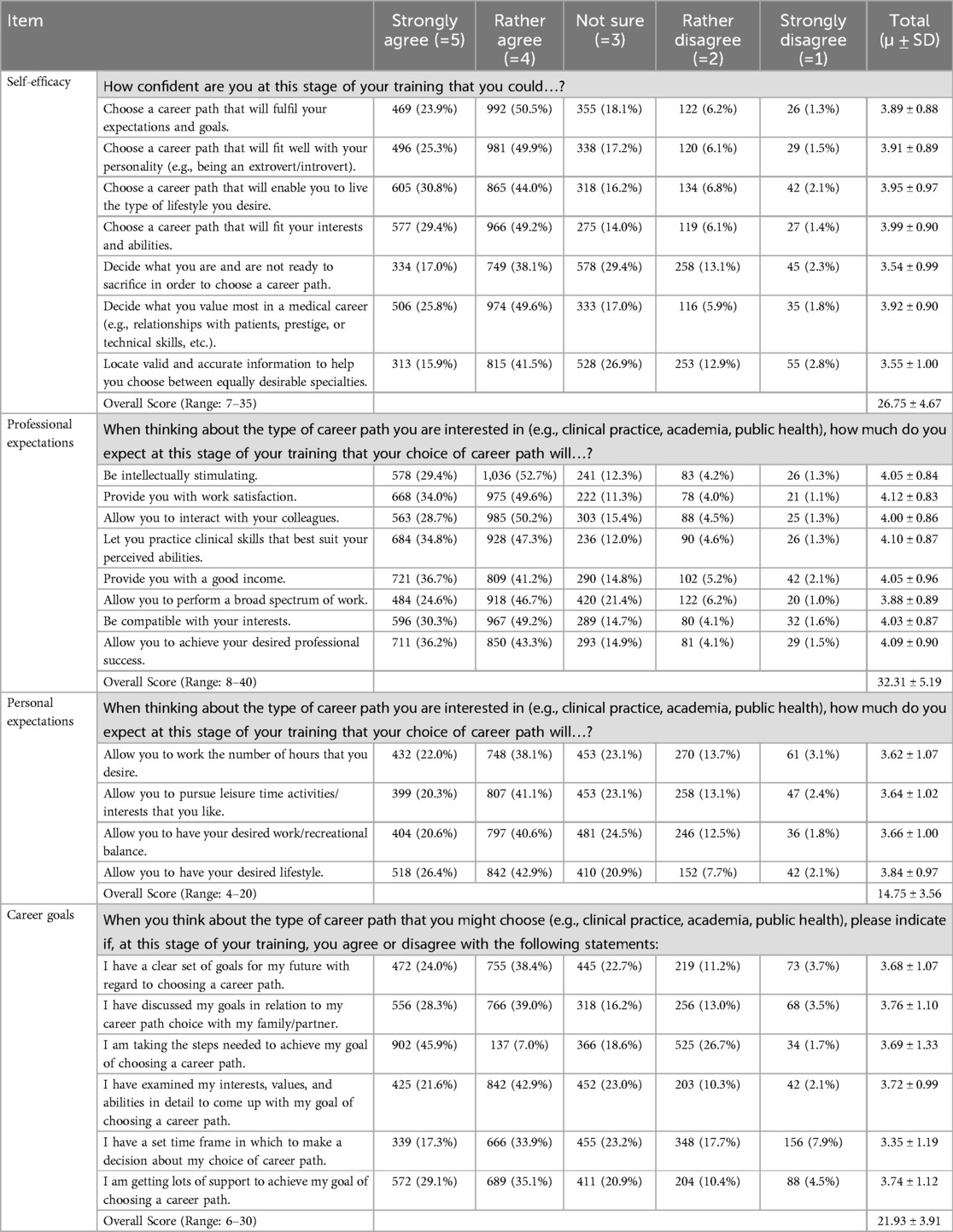
Table 2. Self-efficacy, professional expectations, personal expectations and career goals of dental students participating in FDI–IADS–EDSA survey of career planning, May–July 2023, (n = 1,964).
No statistically significant difference was found in self-efficacy scores between female (26.67 ± 4.74) and male (26.97 ± 4.49) participants, or between students aged ≤ 22 years (26.65 ± 4.78) and those >22 years (26.90 ± 4.51). However, international students (27.95 ± 4.69), pre-clinical students (26.99 ± 4.87), and those who received career planning training (28.47 ± 4.50) had significantly higher self-efficacy scores (p. < 0.001, p. = 0.046, and p. < 0.001, respectively) than domestic students (26.58 ± 4.64), clinical students (26.64 ± 4.57), and those who did not receive career planning training (26.04 ± 4.55) (Table 3).
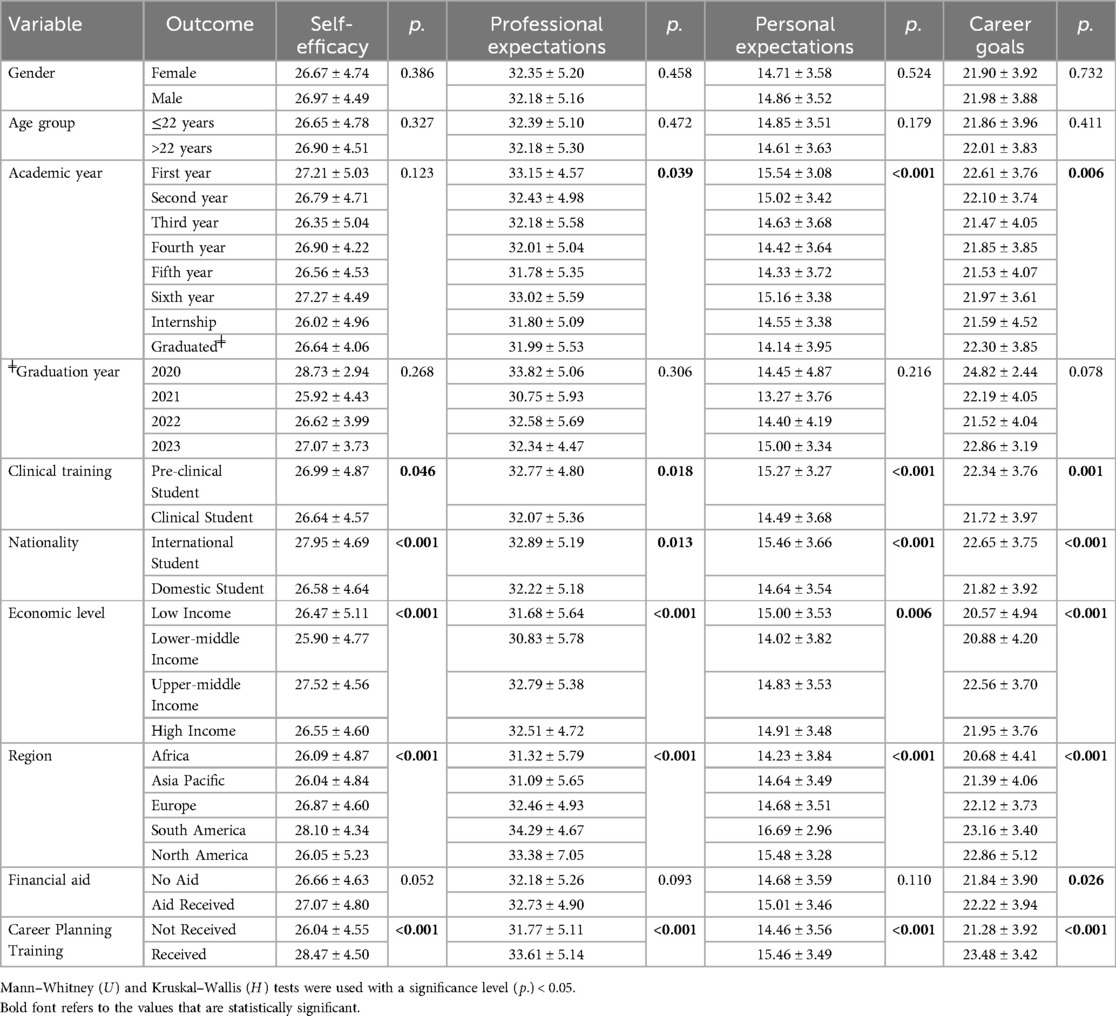
Table 3. Overall scores of self-efficacy, professional expectations, personal expectations and career goals among dental students participating in FDI–IADS–EDSA survey of career planning, stratified by sociodemographic characteristics, May–July 2023, (n = 1,964).
Regarding their professional expectations, 82.2% of participants believed their chosen career path would be intellectually stimulating, while 83.7% anticipated it would offer work satisfaction. Additionally, 78.8% expected their career to facilitate interaction with colleagues, and 82.1% felt it would allow them to practice clinical skills aligned with their perceived abilities. Furthermore, 77.9% expected their career to provide a good income, 71.4% believed it would enable them to perform a wide range of work, 79.6% felt it would be compatible with their interests, and 79.5% anticipated it would help them achieve their desired professional success. The mean score of the professional expectations subscale was 32.31 ± 5.19 (range: 8–40) (Table 2).
There was no statistically significant difference in professional expectations scores across gender (p. = 0.458) or age groups (p. = 0.472). However, international students (32.89 ± 5.19), pre-clinical students (32.77 ± 4.80), and those who received career planning training (33.61 ± 5.14) demonstrated significantly higher professional expectations scores (p. = 0.013, p. = 0.018, and p. < 0.001, respectively) compared to domestic students (32.22 ± 5.18), clinical students (32.07 ± 5.36), and those without career planning training (31.77 ± 5.11) (Table 3).
In terms of personal expectations, 60.1% of participants believed their chosen career path would allow them to work their desired number of hours. Additionally, 61.4% expected it would enable them to engage in leisure activities and interests they enjoy, 61.2% anticipated achieving a satisfactory work-life balance, and 69.2% felt it would support their desired lifestyle. The mean score of the personal expectations subscale was 14.75 ± 3.56 (range: 4–20) (Table 2).
There was no statistically significant difference in personal expectations scores between genders (p. = 0.524) or age groups (p. = 0.179). However, international students (15.46 ± 3.66), pre-clinical students (15.27 ± 3.27), and those who received career planning training (15.46 ± 3.49) had significantly higher scores (all p. < 0.001) compared to domestic students (14.64 ± 3.54), clinical students (14.49 ± 3.68), and those without career planning training (14.46 ± 3.56) (Table 3).
In evaluating their career goals, 62.5% of participants reported having a clear set of goals for their future career path, and 67.3% had discussed these goals with their families or partners. Moreover, 52.9% had taken the necessary steps to achieve their career goals. Additionally, 64.5% had examined their interests, values, and abilities to determine their career path, 51.2% had established a timeframe for making their decision, and 64.2% were receiving substantial support in pursuing their goals. The mean score of the career goals subscale was 21.93 ± 3.91 (range: 6–30) (Table 2).
There was no statistically significant difference in career goals scores between genders (p = 0.732) or age groups (p = 0.411). However, international students (22.65 ± 3.75), pre-clinical students (22.34 ± 3.76), and those who received career planning training (23.48 ± 3.42) and financial aid (22.22 ± 3.94) had significantly higher scores (p. < 0.001, p. = 0.001, p. < 0.001, and p. = 0.026, respectively) compared to domestic students (21.82 ± 3.92), clinical students (21.72 ± 3.97), and those without career planning training (21.28 ± 3.92) or financial aid (21.84 ± 3.90) (Table 3).
The most preferred career path among participants was specialty clinical dentistry (51.2%), followed by general clinical dentistry (28.1%), business/entrepreneurship (4.2%), academia (3.6%), and public health (2.2%), with approximately 10.7% undecided. If their first preference was not achievable, the second most preferred paths were specialty clinical dentistry (28.6%), general clinical dentistry (24%), academia (13.5%), business/entrepreneurship (12.7%), and public health (6.6%), while around 14.7% did not have a secondary preference (Table 4).

Table 4. Career preferences, and career planning training agencies and preferred Media as reported by dental students participating in FDI–IADS–EDSA survey of career planning, May–July 2023, (n = 1,964).
General clinical dentistry was significantly more common among participants aged over 22 years (32.5% vs. 24.8%; p. < 0.001) and clinical students (29.5% vs. 25.2%; p. = 0.049) compared to their counterparts. Students from high-income countries (34.3%) and North America (42.9%) were the most likely to prefer general clinical dentistry. Conversely, students from low-income countries (60.8%) and South America (67.2%) were more inclined to prefer specialty clinical dentistry. No statistically significant differences were observed in the preference for general or specialty clinical dentistry based on gender, nationality, financial aid, or prior career planning training (Table 5).
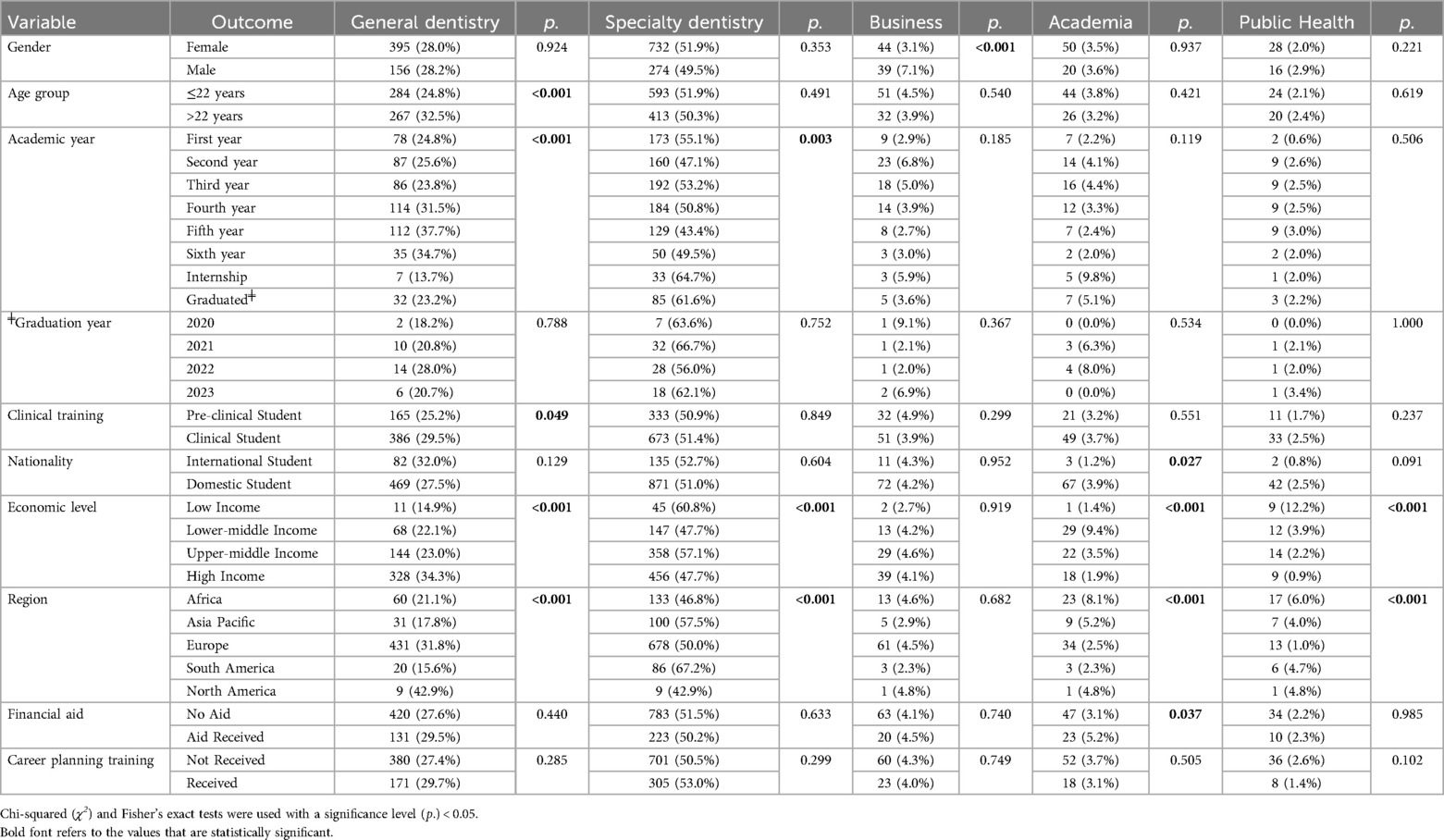
Table 5. First career preferences of dental students participating in FDI–IADS–EDSA survey of career planning, stratified by sociodemographic characteristics, May – July 2023, (n = 1,964).
Business/entrepreneurship was significantly more popular among male students (7.1%) compared to female students (3.1%; p. < 0.001). Academia was more commonly preferred by domestic students (3.9% vs. 1.2%; p. = 0.027) and those receiving financial aid (5.2% vs. 3.1%; p. = 0.037). Students from lower-middle-income countries (9.4%) and Africa (8.1%) were the most likely to choose academia as their primary career path. Regarding the public health career path, students from low-income countries (12.2%) were the most likely to prefer it, followed by those from lower-middle-income (3.9%), upper-middle-income (2.2%), and high-income countries (0.9%). Africa was the region most likely to favour the public health path (6%), while Europe was the least likely (1%; p. < 0.001). (Figure 1).
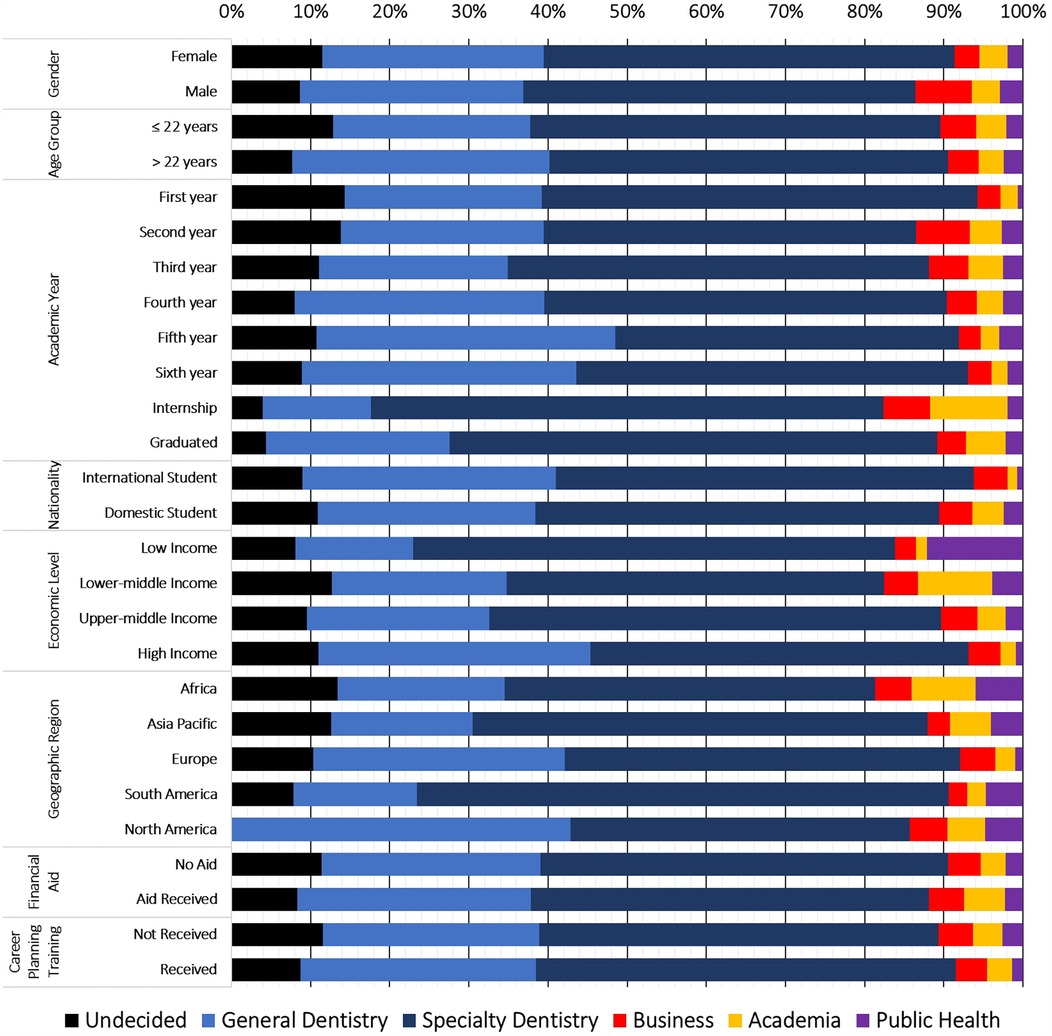
Figure 1. Primary career preferences among dental students participating in the FDI–IADS–EDSA survey of career planning, May–July 2023, (n = 1,964).
Dental schools (89.9%) were the most frequently cited agency responsible for providing career planning training, followed by national dental associations (39.8%), national dental students associations (38.8%), the FDI (32.9%), the IADS (32.5%), regional dental students associations (26.2%), and regional dental associations (24%) (Table 4).
Dental schools were more commonly preferred by students from high-income countries (95%), North America (95.2%), and those who had not previously received career planning training (91.1% vs. 87%, p. = 0.006). Conversely, the FDI was more commonly preferred by those who had received prior career planning training (38.1% vs. 30.8%, p. = 0.002). The IADS was more commonly preferred by participants from low-income countries (41.9%) and South America (47.7%), as well as those receiving financial aid (36.7% vs. 31.3%, p. = 0.033) (Table 6).
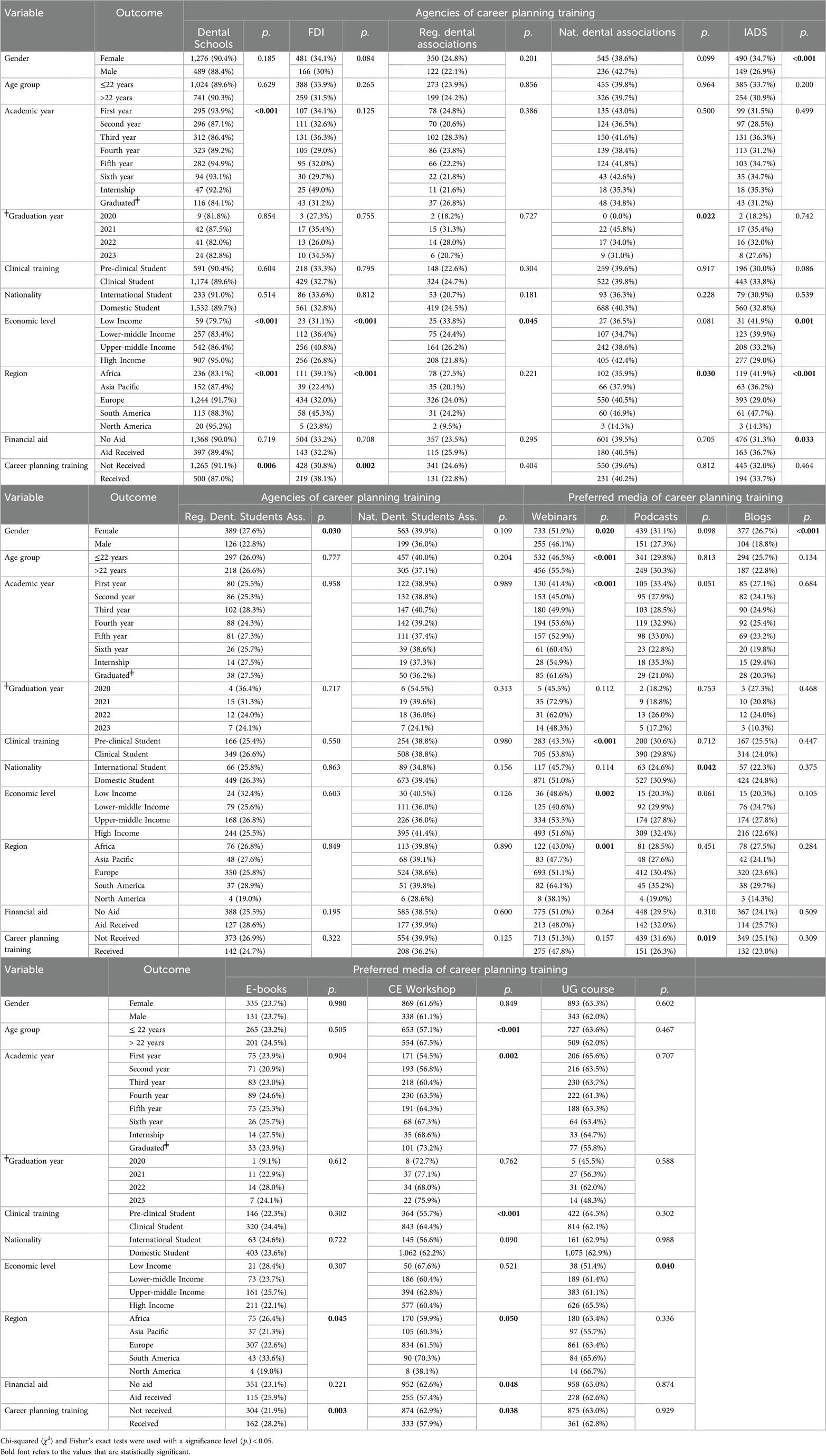
Table 6. Career planning training agencies and preferred Media as reported by dental students participating in FDI–IADS–EDSA survey of career planning, stratified by sociodemographic characteristics, May – July 2023, (n = 1,964).
The most frequently suggested medium for providing career planning training was undergraduate elective courses (62.9%), followed closely by continuous education workshops (61.5%). Virtual media were less frequently suggested: webinars (50.3%), podcasts (30%), blogs (24.5%), and e-books (23.7%). Regarding the timing of undergraduate courses, less than half (49.5%) recommended that these courses be provided during the first years of dental school, while 34.5% suggested they be offered towards graduation during the senior years, and 16% recommended the middle years of dental school, typically coinciding with the beginning of clinical training. Among recent graduates, 84.7% believed that continuous education programs should include components on career management (Table 4).
Female students were significantly more in favour of webinars (51.9% vs. 46.1%; p. = 0.020) and blogs (26.7% vs. 18.8%; p. < 0.001). Students aged over 22 years were more likely to favour webinars (55.5% vs. 46.5%; p. < 0.001) and continuous education workshops (67.5% vs. 57.1%; p. < 0.001). Clinical students were more inclined to favour webinars (53.8% vs. 43.3%; p. < 0.001) and continuous education workshops (64.4% vs. 55.7%; p. < 0.001). Domestic students were more likely to favour podcasts (30.9% vs. 24.6%; p. = 0.042) (Table 6).
Students aged over 22 years were also more likely to support the provision of undergraduate career planning courses in the senior years (24.6% vs. 9.8%; p. < 0.001). Similarly, clinical students were more supportive of offering these courses in the senior years (21.1% vs. 5.8%; p. < 0.001). International students reported receiving career planning training more frequently than their domestic counterparts (36.3% vs. 28.2%; p. = 0.008), and this was also more common among those who received financial aid compared to those who did not (34.2% vs. 27.8%; p. = 0.009) (Table 7).
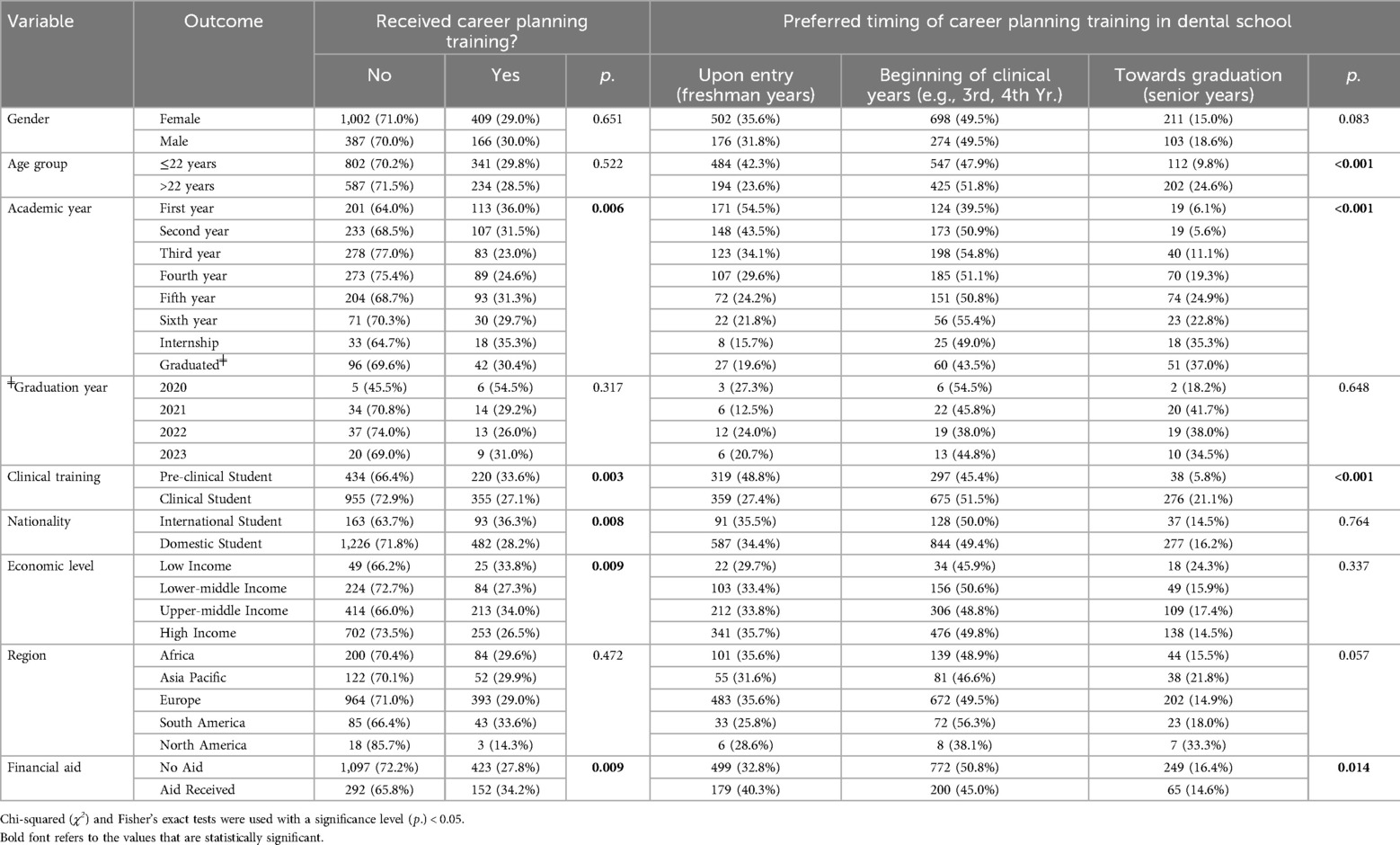
Table 7. Receiving career planning training and its preferred timing in undergraduate curriculum as reported by dental students participating in FDI–IADS–EDSA survey of career planning, stratified by sociodemographic characteristics, May – July 2023, (n = 1,964).
To account for the confounding effects of various sociodemographic and psychological factors, multivariable logistic regression (MLR) models were built to identify predictors of career path preferences, suggested agencies for career planning, and preferred media for career planning training.
The decision to choose general dentistry as a career path was promoted by age [AOR: 1.07 (95% CI: 1.03–1.13)] and personal expectations [1.04 (1.01–1.08)]. Compared to students from low-income countries, those from lower-middle-income countries [2.18 (1.05–4.51)], upper-middle-income countries [1.37 (0.46–4.06)], and high-income countries [2.12 (0.72–6.27)] were more likely to prefer general dentistry. On the contrary, specialty dentistry was dissuaded by age [0.95 (0.91–0.99)] and personal expectations [0.96 (0.93–0.99)]. Compared to students from low-income countries, those from lower-middle-income countries [0.44 (0.25–0.76)], upper-middle-income countries [0.37 (0.16–0.84)], and high-income countries [0.30 (0.13–0.68)] were less likely to prefer specialty dentistry. Professional expectations [1.04 (1.01–1.06)] and career goals [1.03 (1.00–1.06)] were psychological promoters of specialty dentistry (Table 8).
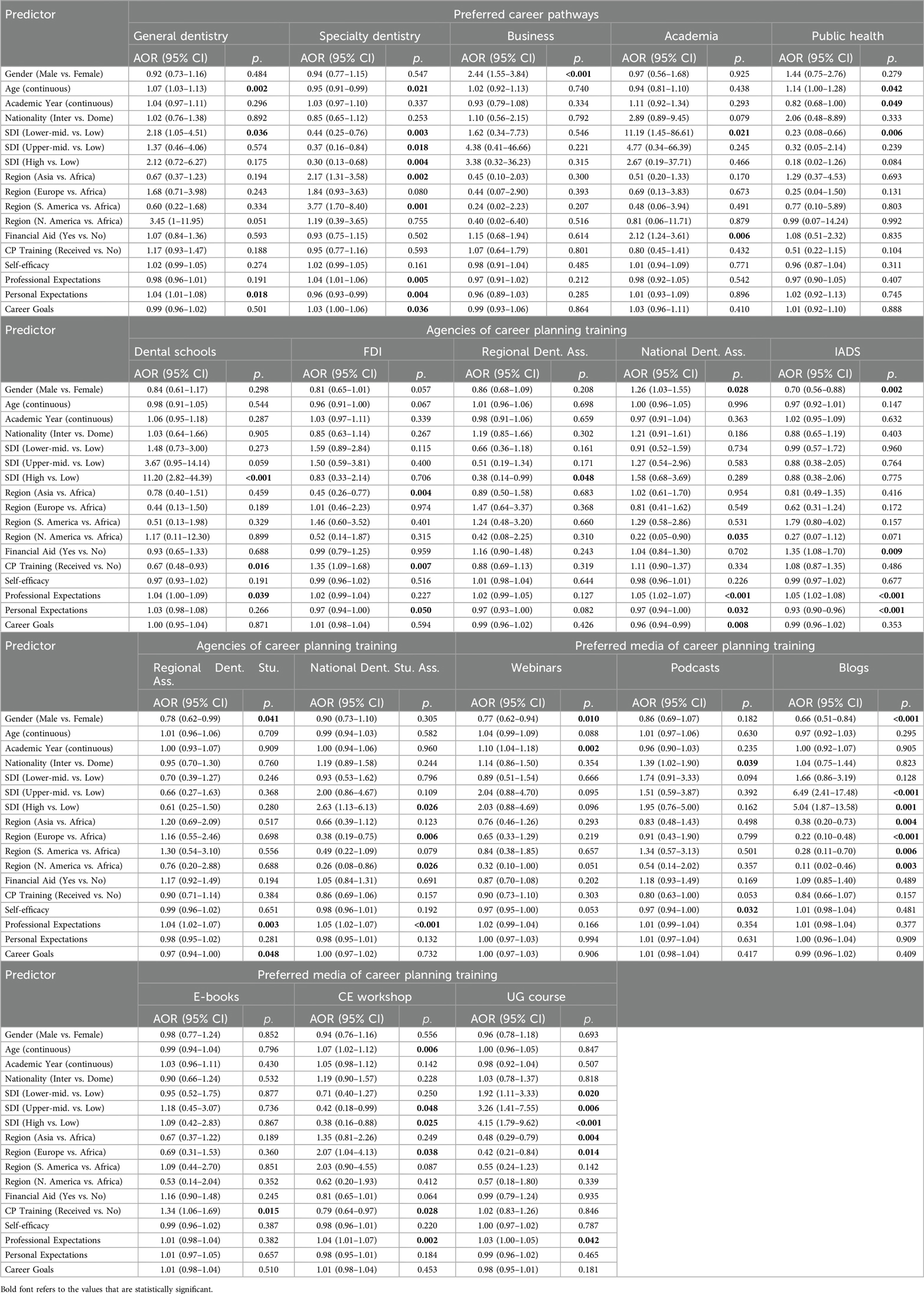
Table 8. Multivariable logistic regression (MLR) models of first career preferences, suggested agencies, and preferred Media as reported by dental students participating in FDI–IADS–EDSA survey of career planning, May – July 2023, (n = 1,964).
The only significant promoter of a business/entrepreneurship career path was male gender [2.44 (1.55–3.84)]. Receiving financial aid was a significant promoter of an academic career path [2.12 (1.24–3.61)], as was being from lower-middle-income countries [11.19 (1.45–86.61)]. The public health career path was promoted by age [1.14 (1.00–1.28)], and it was less common among students from lower-middle-income countries [0.23 (0.08–0.66)], upper-middle-income countries [0.32 (0.05–2.14)], and high-income countries [0.18 (0.02–1.26)] as compared with those from low-income countries (Table 8).
The perceived competency of dental schools in providing career planning training was positively associated with higher professional expectations [1.04 (1.00–1.09)] and being from high-income countries [11.20 (2.82–44.39)], but negatively associated with prior career planning training [0.67 (0.48–0.93)]. In contrast, prior training increased the likelihood of suggesting the FDI as a competent agency [1.35 (1.09–1.68)]. Regional dental associations were less favoured by students from high-income countries [0.38 (0.14–0.99)], upper-middle-income countries [0.51 (0.19–1.34)], and lower-middle-income countries [0.66 (0.36–1.18)] compared to those from low-income countries. Professional expectations [1.05 (1.02–1.07)] and male gender [1.26 (1.03–1.55)] were positively associated with higher odds of favouring national dental associations (Table 8).
The IADS was less commonly preferred by male students [0.70 (0.56–0.88)], whereas it was more commonly preferred by students who received financial aid [1.35 (1.08–1.70)]. Higher professional expectations [1.05 (1.02–1.08)] increased the odds of favouring the IADS, while higher personal expectations [0.93 (0.90–0.96)] decreased them. Additionally, male gender was associated with lower odds of favouring regional dental students' associations, such as EDSA [0.78 (0.62–0.99)] (Table 8).
Virtual media outlets were less favoured by male students, including webinars [0.77 (0.62–0.94)] and blogs [0.66 (0.51–0.84)]. Advancing age and academic year were associated with higher odds of favouring continuous education workshops [1.07 (1.02–1.12)] and webinars [1.10 (1.04–1.18)], respectively. Compared to students from low-income countries, continuous education workshops were less preferred by students from lower-middle-income [0.71 (0.40–1.27)], upper-middle-income [0.42 (0.18–0.99)], and high-income countries [0.38 (0.16–0.88)]. Conversely, undergraduate courses were more preferred by students from lower-middle-income [1.92 (1.11–3.33)], upper-middle-income [3.26 (1.41–7.55)], and high-income countries [4.15 (1.79–9.62)] (Table 8).
The mediation analyses aimed to explore the effect of prior career planning training on preferred career paths through the SCCT components.
For general dentistry, career planning training significantly enhanced self-efficacy [2.43 (1.99–2.87)], professional expectations [1.84 (1.35–2.34)], personal expectations [1.01 (0.66–1.35)], and career goals [2.21 (1.84–2.57)]. However, none of these factors had a significant direct effect on the preference for general dentistry, indicating that these factors partially mediated the relationship between career planning training and the choice of general dentistry with mediation contributions of 26.7%, 4.94%, 21.2%, and 37.1% respectively (Figure 2A).
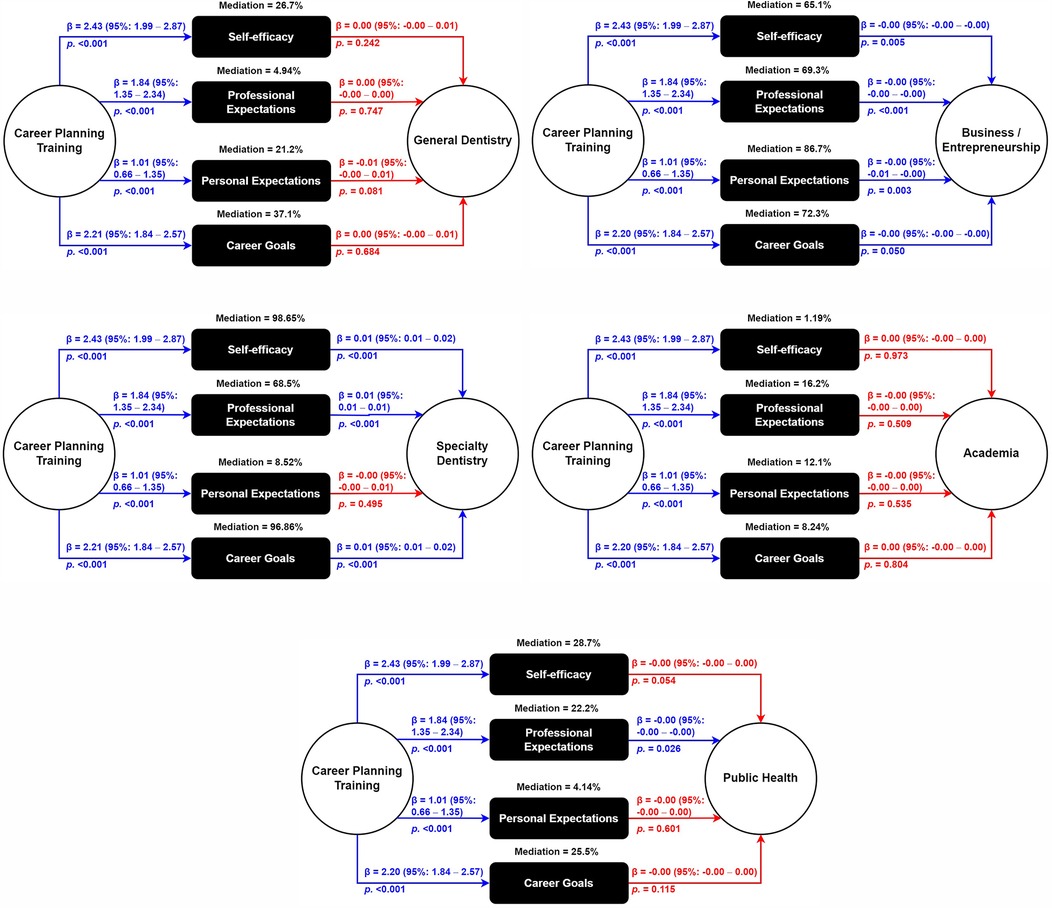
Figure 2. Mediation analysis for the effect of self-efficacy, professional expectations, personal expectations, and career goals on the relationship between career planning training (predictor) and primary career preferences (outcome) among dental students participating in the FDI–IADS–EDSA survey of career planning, May–July 2023, (n = 1,964).
For specialty dentistry, training significantly increased self-efficacy [2.43 (1.99–2.87)], professional expectations [1.84 (1.35–2.34)], personal expectations [1.01 (0.66–1.35)], and career goals [2.21 (1.84–2.57)]. Self-efficacy [0.01 (0.01–0.02)], professional expectations [0.01 (0.01–0.01)], and career goals [0.01 (0.01–0.02)] had significant direct effects on specialty dentistry preference, demonstrating substantial mediation with contributions of 98.65%, 68.5%, and 96.86%, respectively (Figure 2B).
For business/entrepreneurship, training improved self-efficacy [2.43 (1.99–2.87)], professional expectations [1.84 (1.35–2.34)], personal expectations [1.01 (0.66–1.35)], and career goals [2.20 (1.84–2.57)]. However, all these factors had direct negative effects on this career path, with considerable mediation contributions of 65.1%, 69.3%, 86.7%, and 72.3% (Figure 2C).
For academia, training enhanced self-efficacy [2.43 (1.99–2.87)], professional expectations [1.84 (1.35–2.34)], personal expectations [1.01 (0.66–1.35)], and career goals [2.20 (1.84–2.57)]. None of these factors had a significant direct impact on preferring academia, indicating minimal or negligible mediation with contributions of 1.19%, 16.2%, 12.1%, and 8.24% (Figure 2D).
For public health, training increased self-efficacy [2.43 (1.99–2.87)], professional expectations [1.84 (1.35–2.34)], personal expectations [1.01 (0.66–1.35)], and career goals [2.20 (1.84–2.57)]. Nevertheless, all these factors negatively influenced the preference for public health, with partial mediation contributions of 28.7%, 22.2%, 4.14% and 25.5% (Figure 2E).
This study aimed to explore how aspects of the SCCT, such as self-efficacy, outcome expectations and career goals, shape the career decisions of dental students across various career pathways such as General Dentistry, Specialty Dentistry, Business/Entrepreneurship, Academia and Public Health. Expectations and influences in students' career choices have long been a topic of interest as such insights help shape the approach of educational institutions in providing guidance during the students' formational years (1, 11). Previous studies have explored factors such as professional satisfaction, intrinsic motivations and financial stability (20–28).
To the best of our knowledge, the currently available literature is mostly region-specific and does not implement a comprehensive theoretical model in their analysis. For instance, Gallagher et al. (2008, 2009) examined career expectations among dental students at a single London Dental School (20, 21). Ellakany et al. (2023) focused on career satisfaction among dental students and dentists in Saudi Arabia, while Che Musa et al. (2016) analysed career influences among dental students in Malaysia, each with a narrow national focus (22, 23). Additionally, Sam et al. (2016) investigated working environments and speciality choices among students in a single university in Saudi Arabia, with a similar narrow focus and lack of comprehensive modelling (29). These studies illustrate the regional focus of current literature and, while diverse in their investigated aspects, they lack a holistic theoretical approach, thus limiting their broader applicability. In this aspect, the present study is a pioneer in providing a more nuanced understanding, through the prism of the SCCT framework, into the influencing factors of career path choices of dental students globally, addressing the gaps in regionally focused studies. Given the nature of the study design, the findings provide crucial insight for developing targeted interventions and career guidance programs to support dental students' decision-making process in their career planning, tailored to the specific needs of their diverse environmental context.
The findings revealed levels of uncertainty among students regarding their capacity to make an informed decision on their career pathway such that it would align with their goals, personality and lifestyle. It is important to explore this uncertainty within the context of the student's education as much as their environment. The multivariable regression analysis showed that students who reported career planning training (CPT) exhibited a higher self-efficacy, highlighting the importance of structured guidance in boosting their confidence in the decision-making process. This aligns accurately with existing literature and additionally with the mediation analysis, which highlighted CPT as a key mediator, positively impacting self-efficacy, especially for those pursuing speciality dentistry (28, 30, 31). When placed within the sociodemographic context, the higher self-efficacy among international and pre-clinical students could indicate that early career exploration and early exposure to information on the diverse opportunities within their field may help students feel more confident about their career choices (25, 27).
Another interesting finding was the difference in self-efficacy between pre-clinical and clinical students, with the former reporting higher levels of self-efficacy. The drop in self-efficacy seen in clinical students may be attributed to increased pressures and challenges they face during their training, as they are exposed to the demands of clinical practice and the complexities of patient care (32, 33).
Notably high professional expectations among participants were observed, with over 80% expecting intellectual stimulation and work satisfaction, in accordance with the outcomes of Gallagher et al. (20, 21)
CPT is observed, again, as a significant factor in boosting both professional and personal expectations, with students who received prior training on their career planning reporting higher confidence in their future careers. The mediation analysis revealed that professional expectations served as a significant mediator in the preference for speciality dentistry, where students who received CPT exhibited a stronger likelihood of pursuing advanced specialities. These findings reinforce the role of structured guidance in shaping professional expectations and satisfaction (21–23).
International students and those in their pre-clinical years showing higher professional expectations as compared to domestic and clinical students is a reiteration of the importance of early exposure to more diverse healthcare system settings and career opportunities as well as the need for ongoing career support through the senior years of their studies, to tackle the gap in perception between students' early expectations and the realities they encounter later into their career (30, 33).
Personal expectations—such as work-life balance, lifestyle compatibility and participation in leisure activities—were also influenced by CPT. The regression analysis revealed that students with higher personal expectations were more likely to choose general dentistry. This could be attributed to lifestyle factors weighing in on the decision to pursue a less demanding and stable career path. The mediation analysis did not show personal expectations as a strong mediator, especially in terms of special dentistry, as compared to professional expectations; however, they still played a role in shaping career preferences.
Overall, personal and professional expectations were significant mediators across all career paths, showing that CPT helps clarify students' understanding of how their careers can meet personal and professional needs.
A significantly high portion of the participants reported having clear career goals (62.5%) and discussing their goals with their families and partners (73.7%) This finding places the role of community and social support in a strongly shaping position for students' career aspirations (34).
Another interesting factor playing into the career goal clarity was found to be financial aid. The findings suggest that economic support can alleviate the pressure of financial burden and allow students to focus more on their long-term professional development (25). This aligns with other studies where financial concerns were evaluated to dictate or limit students' career choices, particularly in lower-income regions (28, 32, 35).
Consistent with goal-setting theory, students with well-defined career goals were more likely to pursue specialty careers and entrepreneurial paths (36). The multivariable logistic regression analysis identified age and personal expectations as key predictors for career path preferences.
The mediation analysis further demonstrated that career planning training (CPT) positively influenced self-efficacy, professional expectations, and career goals, especially for students choosing specialty dentistry. In concordance with current literature, the dominance of specialty clinical dentistry (51.2%) as the most preferred career path, both as a first and second choice, indicates a strong interest among dental students to specialize, particularly in lower-income countries (23, 25, 28). General clinical dentistry on the other hand was more preferred among older students and those in their clinical years and higher-income countries. This could be attributed to the desire for faster integration into the workforce and job stability among senior dental students or recent graduates, which is consistent with previous findings from Gallagher et al. (20, 21) Similarly, such preference from students in higher-income countries could also be attributed to the perceived financial stability and job market within the country's context (30–32).
However, according to the mediation analysis results, for non-clinical paths such as business/entrepreneurship and public health, CPT seemed to negatively influence preferences. Public health was less popular among students from higher-income countries, which was unexpected. While previous research has suggested public health careers might appeal to students due to their societal impact, the results indicate that financial considerations may deter students from pursuing public health, especially in wealthier regions (20, 21). Conversely, students from lower-income regions demonstrated greater interest in public health, reflecting the pressing societal needs in these areas and the strong commitment to addressing public health challenges where healthcare resources are limited (26, 35, 37). Moreover, the weaker effect of CPT for Academia (8.24%) in the mediation analysis, suggests that other factors, such as academic mentorship or research opportunities, may play a larger role. This is consistent with research suggesting that academic careers often evolve over time and are influenced by factors like mentorship and research interests rather than predefined career goals set early in one's education (34, 38).
The significant gender differences in the preference for business/entrepreneurship, where male students exhibited a stronger inclination, reflect traditional societal roles and expectations regarding financial independence and leadership, which persist across many regions despite evolving norms in the healthcare sector (21, 31, 39). These findings suggest that gender dynamics continue to influence career aspirations, even in fields where gender representation is becoming more balanced. Taken together, these results emphasise the need for culturally sensitive career guidance that considers sociocultural factors in shaping career goals and preferences.
When career planning agencies and preferred media are considered, the logistic regression findings align well with students' stated preferences for dental schools as the most reliable CPT source, especially in high-income countries (23, 25, 28, 33). National and international associations such as the IADS were more favoured by students from low-income countries, underscoring the need for global networking and support systems for students with fewer local resources.
Interestingly, Gen Z students still preferred in-person training over digital platforms. This suggests that students highly value personal interaction with mentors and career advisors, even in an era of digital learning. This is supported by findings from Garcia et al., who investigated the effect of COVID-19 on the career perspective of dental and dental hygienist students—their findings concluded that according to student perception of the effect of the pandemic on their education, they reported a negative effect on the preclinical and clinical training pointing at the fatigue of virtual learning and the absence of hands-on practice (40).
The findings strongly support the idea that dental schools should integrate structured career counselling into their curricula to enhance students' self-efficacy and align their career goals with realistic professional expectations.
The findings confirm the applicability of SCCT in explaining dental students' career aspirations across diverse contexts. However, regional adaptations may be necessary to account for variations in professional and personal expectations, particularly in the socioeconomic context. Additionally, while this study provides significant insights into the role of Career Planning Training, it is limited by its cross-sectional design, which prevents us from drawing causal inferences. Future longitudinal studies could explore how changes in self-efficacy and professional expectations over time affect career choices. Furthermore, the overrepresentation of European participants and the underrepresentation of regions such as Asia-Pacific may limit the global generalizability of the findings. However, subgroup analyses and regression models were applied to account for regional differences, ensuring the results remain interpretable across diverse educational and professional contexts. Finally, while the SCCT components, i.e., self-efficacy, outcome expectations, and career goals, were examined, the influence of role models on career decisions was not assessed. Given the documented impact of mentorship on career trajectories, future research should incorporate this factor for a more comprehensive understanding of career aspirations.
These findings have important implications for dental education and policy. National dental associations and schools should work collaboratively to create tailored career planning programs that address the unique needs of students in their pertaining regions. Moreover, organizations like FDI and IADS could focus on creating general CPT guidelines that can be adapted to local contexts, rather than providing CPT directly. Future research should continue exploring how CPT interventions can be tailored to students' specific career goals and regional job market conditions.
This study offers new insights into the global career aspirations of dental students through the lens of the SCCT. The findings show that structured career planning programs can significantly enhance students' ability to make informed decisions about their future.
The differences in career aspirations based on income level and geographic region underline the need for more personalised career planning training, particularly in low-income areas where students may have fewer resources and less support. By increasing access to career planning training and focusing on building students' confidence and informed awareness of the available career opportunities, dental schools and associations can help ensure that students are better prepared for the diverse opportunities within the dental field.
The data that support the findings of this study are available from the corresponding author upon reasonable request.
This study was reviewed and approved by the Ethics Committee of the Faculty of Medicine, Masaryk University (decision no. 12/2023). The study was conducted in accordance with the local legislation and institutional requirements. The participants provided their informed consent to participate in this study electronically.
AR: Conceptualization, Formal analysis, Funding acquisition, Investigation, Methodology, Project administration, Software, Supervision, Validation, Writing – original draft. LE: Conceptualization, Project administration, Writing – original draft. SD: Data curation, Investigation, Writing – original draft, Software. AD: Writing – original draft. CC: Conceptualization, Investigation, Writing – review & editing. DK: Data curation, Investigation, Writing – review & editing. EV: Formal analysis, Writing – original draft. RE: Conceptualization, Funding acquisition, Project administration, Resources, Writing – review & editing. MM: Data curation, Funding acquisition, Writing – review & editing. JI: Data curation, Writing – review & editing. SA: Data curation, Writing – review & editing. MA: Methodology, Writing – review & editing. DH: Methodology, Writing – review & editing. AB: Methodology, Writing – review & editing. ID: Writing – review & editing, Investigation, Data curation. ED: Data curation, Writing – review & editing, Investigation.
Faculty of Dentistry, University of Medical Sciences and Technology, Khartoum, Sudan: Aya Abdelrahim. College of Dentistry, Kuwait University, Kuwait City, Kuwait: Yousif Alhasan. Faculty of Dentistry, Istanbul Medipol University, Istanbul, Türkiye: Selim Tunahan Akçay. Faculty of Dentistry, Hacettepe University, Ankara, Türkiye: Osman Çaksen. Faculty of Dentistry, Aldent University, Tirana, Albania: Ersid Domnori. Faculty of Dentistry, Universidad de San Carlos de Guatemala, Guatemala City, Guatemala: Andrea Martinez, Gabriela Molina, Juan Fernando Morales. Faculty of Dentistry, Alamein International University, New Alamein City, Egypt: Aya Eida. Faculty of Dentistry, Alexandria University, Alexandria, Egypt: Gamal ElGhonemy. Faculty of Dentistry, Al Neelain University, Khartoum, Sudan: Zeinab Hassan. Faculty of Dentistry, University of Khartoum, Khartoum, Sudan: Rawan Mahmoud. Faculty of Dentistry, University of Medicine, Tirana, Albania: Eni Shaqiri. Faculty of Dentistry, Istanbul Medipol University, Istanbul, Türkiye: Zeynep Önen.
Faculty of Dental Surgery, Nantes Université, Nantes, France: Inès Bouillaud. School of Dental Medicine, University of Zagreb, Zagreb, Croatia: Klara Križan, Matija Borovac. School of Dental Medicine, University of Bern, Bern, Switzerland: Yanik Bossi. Faculty of Dentistry, University of Porto, Porto, Portugal: Diana Correia. Oral & Maxillofacial Surgery Department, University Clinical Center of Kosovo: Behar Dalipi. Faculty of Dental Medicine, Medical University of Plovdiv, Plovdiv, Bulgaria: Ivan Demyanov. Faculty of Dentistry, University of Coimbra, Coimbra, Portugal: Bianca Gomes. Faculty of Dentistry, Riga Stradiņš University, Riga, Latvia: Kristīne Romanovska, Luīze Lote Liepiņa, Paula Paegle. Faculty of Medicine, University of Ljubljana, Ljubljana, Slovenia: Tjaša Miklavčič. Faculty of Medicine, Charles University, Pilsen, Czech Republic: Jana Panochová. University Center for Dental Medicine Basel, University of Basel, Basel, Switzerland: Mark RutscheidtCenter of Dental Medicine, University of Zurich, Zurich, Switzerland: Bogomil Sabev. Faculty of Dentistry, University of Lisbon, Lisbon, Portugal: Mafalda Silva. Faculty of Dental Medicine, University of Rijeka, Rijeka, Croatia: Elizabeta Vrkljan.
The author(s) declare that financial support was received for the research and/or publication of this article. This study was supported by the NPO “Systemic Risk Institute” no. LX22NPO5101, funded by European Union–Next Generation EU (Ministry of Education, Youth and Sports, NPO: EXCELES).
This work was commissioned by FDI World Dental Federation. The authors would like to express their sincere gratitude to the following colleagues for their valuable support to this work: Xhevahire Vrenezi and Bojan Poposki (Ss. Cyril and Methodius University Skopje, North Macedonia), Ave Põld (Heidelberg University, Germany), Meryem Lahlou (Mohammed VI Health Sciences University, Morocco), Eya Khemir (University of Monastir, Tunisia), Tasneem Muhsen and Hiba Al Kharraz (Jordan University of Science and Technology, Jordan), Hala Rabah (University of Jordan, Jordan), Nadyn Permata and Viandra Salsabilla (University of Indonesia, Indonesia), Saulė Skinkytė (Vilnius University, Lithuania), Elian Mauricio Valdés Martínez (Universidad Autónoma del Estado de México, Mexico), Mayar Danadneh, Osama Ewineh, and Mays Mahariq (Al-Quds University, Palestine), Clement Bonheur Izabayo and Jean Claude Uwihoreye (University of Rwanda, Rwanda), and Shukri Jama (Hacettepe University, Türkiye). Their assistance have been invaluable in the completion of this project.
The authors declare that the research was conducted in the absence of any commercial or financial relationships that could be construed as a potential conflict of interest.
The author(s) declare that Generative AI was used in the creation of this manuscript. The authors declare that Generative AI, specifically OpenAI's ChatGPT (version 4), was used in preparing this manuscript. ChatGPT was solely used in proofreading and refining language to enhance readability. All intellectual content, research findings, and substantive elements were independently developed by the authors.
All claims expressed in this article are solely those of the authors and do not necessarily represent those of their affiliated organizations, or those of the publisher, the editors and the reviewers. Any product that may be evaluated in this article, or claim that may be made by its manufacturer, is not guaranteed or endorsed by the publisher.
The Supplementary Material for this article can be found online at: https://www.frontiersin.org/articles/10.3389/froh.2025.1577870/full#supplementary-material
1. Dudovitz RN, Chung PJ, Nelson BB, Wong MD. What do you want to be when you grow up? Career aspirations as a marker for adolescent well-being. Acad Pediatr. (2017) 17:153–60. doi: 10.1016/j.acap.2016.08.006
2. International Labour Organization (ILO). Youth Aspirations and the Future of Work: A Review of the Literature and Evidence. Working Papers. (n.d.). Available at: https://webapps.ilo.org/static/english/intserv/working-papers/wp008/index.html (Accessed March 12, 2025).
3. Akosah-Twumasi P, Emeto TI, Lindsay D, Tsey K, Malau-Aduli BS. A systematic review of factors that influence youths career choices—the role of culture. Front Educ (Lausanne). (2018) 3:348903. doi: 10.3389/feduc.2018.00058
4. Marcionetti J, Zammitti A. Perceived support and influences in adolescents’ career choices: a mixed-methods study. Int J Educ Vocat Guid. (2023):1–24. doi: 10.1007/s10775-023-09624-9
5. National Association of Colleges and Employers (NACE). Development and Validation of the NACE Career Readiness Competencies. Career Readiness. (n.d.). Available at: https://naceweb.org/uploadedFiles/files/2022/resources/2022-nace-career-readiness-development-and-validation.pdf (Accessed March 12, 2025).
6. Mosia PA, Lephoto MN. Non-governmental and community-based organisations as enablers of inclusion in education. In: Hlalele D, Makoelle TM, editors. Inclusion in Southern African Education. Sustainable Development Goals Series. Cham: Springer (2023). p. 209–21. doi: 10.1007/978-3-031-43752-6_15
7. Siddiky MR, Akter S. The students’ career choice and job preparedness strategies: a social environmental perspective. Int J Eval Res Educ (IJERE). (2021) 10:421–31. doi: 10.11591/IJERE.V10I2.21086
8. LaMorte WW. The Social Cognitive Theory. Behavioral Change Models. (2022). Available at: https://sphweb.bumc.bu.edu/otlt/mph-modules/sb/behavioralchangetheories/behavioralchangetheories5.html (Accessed June 30, 2023).
9. Lent RW, Brown SD. Social Cognitive Career Theory and Adult Career Development. Adult Career Development: Concepts, Issues and Practices,. 3rd ed. Columbus, OH, US: National Career Development Association (2002). p. 76–97.
10. Godin G, Bélanger-Gravel A, Eccles M, Grimshaw J. Healthcare professionals’ intentions and behaviours: a systematic review of studies based on social cognitive theories. Implement Sci. (2008) 3:1–12. doi: 10.1186/1748-5908-3-36
11. Rogers ME, Creed PA, Searle J. The development and initial validation of social cognitive career theory instruments to measure choice of medical specialty and practice location. J Career Assess. (2009) 17:324–37. doi: 10.1177/1069072708330676
12. Von Elm E, Altman DG, Egger M, Pocock SJ, Gøtzsche PC, Vandenbroucke JP. The strengthening the reporting of observational studies in epidemiology (STROBE) statement: guidelines for reporting observational studies. UroToday Int J. (2007) 335:806–8. doi: 10.1136/bmj.39335.541782.ad
13. Kobo Inc. About the Kobo Organization. KoboToolbox. (n.d.). Available at: https://www.kobotoolbox.org/about-us/the-organization/ (Accessed May 16, 2024).
14. Centers for Disease Control and Prevention (CDC). Epi Info™ for Windows. (2020). Available at: https://www.cdc.gov/epiinfo/pc.html (Accessed December 25, 2020).
15. World Bank. World Bank Country and Lending Groups. World Bank Data Help Desk. (2021). Available at: https://datahelpdesk.worldbank.org/knowledgebase/articles/906519-world-bank-country-and-lending-groups (Accessed March 14, 2021).
16. World Dental Federation FDI. Regional Organizations. Our Members. (n.d.). Available at: https://www.fdiworlddental.org/regional-organizations (Accessed August 10, 2023).
17. Curran PG. Methods for the detection of carelessly invalid responses in survey data. J Exp Soc Psychol. (2016) 66:4–19. doi: 10.1016/J.JESP.2015.07.006
18. SPSS Inc. IBM SPSS Statistics 28 2021. Available at: https://www.ibm.com/support/pages/ibm-spss-statistics-28-documentation (Accessed January 7, 2023).
19. The jamovi project. jamovi (Version 2.3) [Computer Software]. (2022). Available at: https://www.jamovi.org (Accessed January 7, 2023).
20. Gallagher JE, Clarke W, Wilson NHF. The emerging dental workforce: short-term expectations of, and influences on dental students graduating from a London dental school in 2005. Prim Dent Care. (2008) 15:93–101. doi: 10.1308/135576108784795392
21. Gallagher JE, Patel R, Wilson NHF. The emerging dental workforce: long-term career expectations and influences. A quantitative study of final year dental students’ views on their long-term career from one London Dental School. BMC Oral Health. (2009) 9:1–9. doi: 10.1186/1472-6831-9-35
22. Ellakany P, Aly NM. Career satisfaction amongst dental students and dentists in Saudi Arabia: a cross-sectional survey. Eur J Dent Educ. (2023) 27:144–8. doi: 10.1111/EJE.12786
23. Che Musa MF, Bernabé E, Gallagher JE. Career expectations and influences among dental students in Malaysia. Int Dent J. (2016) 66:229–36. doi: 10.1111/IDJ.12224
24. Arhoma N, Tantawi M, Arheiam A. Career expectations and the motivating factors for studying dentistry in Libya. BMC Med Educ. (2022) 22:1–7. doi: 10.1186/S12909-022-03933-3
25. Alrashdan MS, Alazzam M, Alkhader M, Phillips C. Career perspectives of senior dental students from different backgrounds at a single Middle Eastern institution. BMC Med Educ. (2018) 18:1–9. doi: 10.1186/s12909-018-1386-9
26. Halawany HS. Career motivations, perceptions of the future of dentistry and preferred dental specialties among Saudi dental students. Open Dent J. (2014) 8:129. doi: 10.2174/1874210601408010129
27. Du TJ, Jain S, Montalli V, Govender U. Dental students’ motivations for their career choice: an international investigative report. J Dent Educ. (2014) 78:605–13. doi: 10.1002/j.0022-0337.2014.78.4.tb05712.x
28. Batyrbekova G, Coban T, Hekimoglu C, Pak DY, Şahin MB, Guncu MB, et al. Future expectations, career choices and related factors among dental students: a cross-sectional study. Eur Oral Res. (2022) 56:88–95. doi: 10.26650/EOR.2022932541
29. Sam G, Alghmlas AS, Alrashed MI, Alaskar ZA. Working environment and specialty of choice chosen by the dental students at Prince Sattam Bin Abdulaziz University, Saudi Arabia: a cross-sectional study. J Int Soc Prev Community Dent. (2016) 6:S1–5. doi: 10.4103/2231-0762.181159
30. Lee Y, Ross AJ. Projected speciality career choices among undergraduate dental students in Scotland. Br Dent J. (2017) 224:32–7. doi: 10.1038/sj.bdj.2017.1002
31. Shin JH, Kinnunen TH, Zarchy M, Da Silva JD, Chang BMW, Wright RF. Factors influencing dental Students’ specialty choice: a survey of ten graduating classes at one institution. J Dent Educ. (2015) 79:369–77. doi: 10.1002/j.0022-0337.2015.79.4.tb05893.x
32. M’manga CB, Shuliang M. Personality, career decision-making and career expectations: a primary report from Malawi. J Behav Sci. (2019) 14:62–75. Available at: https://so06.tci-thaijo.org/index.php/IJBS/article/view/174855
33. Mohebbi SZ, Gholami M, Chegini M, Ghoreyshi Y, Gorter RC, Bahramian H. Impact of career choice motivation on academic burnout in senior dental students: a cross-sectional study. BMC Med Educ. (2021) 21:1–8. doi: 10.1186/s12909-020-02475-w
34. Slavkin HC. The impact of research on the future of dental education: how research and innovation shape dental education and the dental profession. J Dent Educ. (2017) 81:eS108–27. doi: 10.21815/JDE.017.041
35. Leitão M, Guedes Á, EmíliaYamamoto M, de Araújo Lopes F. Do people adjust career choices according to socioeconomic conditions? An evolutionary analysis of future discounting. Psychol Neurosci. (2013) 6:383–90. doi: 10.3922/J.PSNS.2013.3.16
36. Tosi HL, Locke EA, Latham GP. A theory of goal setting and task performance. The Academy Manag Rev. (1991) 16:480. doi: 10.2307/258875
37. Sharma N, Jain K, Kabasi S. Attitude toward public health dentistry as a career among dental students in Odisha: a cross-sectional study. Dent Res J (Isfahan). (2016) 13:532–8. doi: 10.4103/1735-3327.197042
38. D’souza RN, Colombo JS. How research training will shape the future of dental, oral, and craniofacial research. J Dent Educ. (2017) 81:eS73–82. doi: 10.21815/JDE.017.037
39. Kaur T, Raghotham K, Tantry D. Does presence of role models at undergraduate training level impact the choice of specialization as maxillofacial surgery for young women dental graduates?: qualitative study and review of literature. J Maxillofac Oral Surg. (2021):1–5. doi: 10.1007/S12663-021-01556-7
Keywords: career choice, career counselling, continuing dental education, dental societies, dental students, social cognition
Citation: Riad A, Elsheikh L, Domnori S, Doris Fratila A, Carter C, Kaya DD, Volevach E, England R, Morgado M, Issa J, Attia S, Armstrong M, Hammer D, Baigulakov A, IADS Delegates and EDSA Delegates (2025) Career aspirations of dental students: insights from a multinational study using social cognitive career theory (SCCT). Front. Oral Health 6:1577870. doi: 10.3389/froh.2025.1577870
Received: 16 February 2025; Accepted: 25 March 2025;
Published: 11 April 2025.
Edited by:
Fawad Javed, University of Rochester Medical Center, United StatesReviewed by:
Afnan Rahman, HBS Medical and Dental College, PakistanCopyright: © 2025 Riad, Elsheikh, Domnori, Doris Fratila, Carter, Kaya, Volevach, England, Morgado, Issa, Attia, Armstrong, Hammer, Baigulakov, IADS Delegates and EDSA Delegates. This is an open-access article distributed under the terms of the Creative Commons Attribution License (CC BY). The use, distribution or reproduction in other forums is permitted, provided the original author(s) and the copyright owner(s) are credited and that the original publication in this journal is cited, in accordance with accepted academic practice. No use, distribution or reproduction is permitted which does not comply with these terms.
*Correspondence: Lamis Elsheikh, bGFtaXNfYWJkdWxrYXJpbUBob3RtYWlsLmNvbQ==
Disclaimer: All claims expressed in this article are solely those of the authors and do not necessarily represent those of their affiliated organizations, or those of the publisher, the editors and the reviewers. Any product that may be evaluated in this article or claim that may be made by its manufacturer is not guaranteed or endorsed by the publisher.
Research integrity at Frontiers

Learn more about the work of our research integrity team to safeguard the quality of each article we publish.